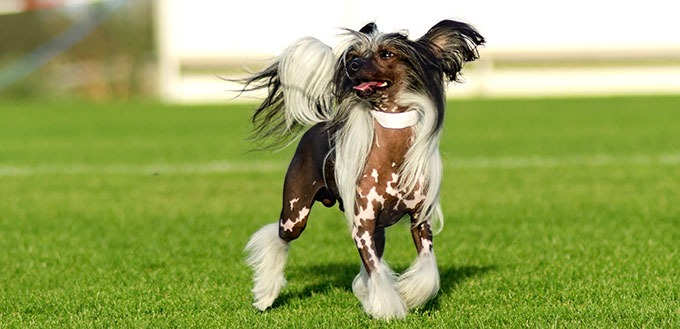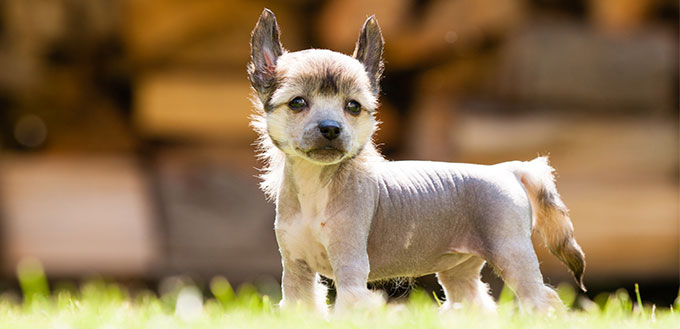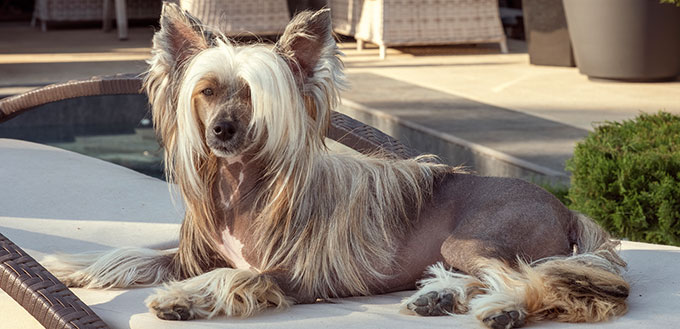You can spot a Chinese Crested dog from a mile away with their spiky ‘crested’ hairstyle. If you are looking for a dog to act as your faithful companion, you can’t get much better. They are a lot of fun and faithfully devoted to their owners. And as they are a hairless breed, they are not going to leave fur all over the house for you to clean up and there is no danger of that ‘doggy smell’. But this is also not your typical dog who is going to enjoy bounding around outside, and they are often content simply relaxing with you at home.
So, here is a bit more interesting information about this breed.
History of the Chinese Crested Dog
The origins of this dog go way back in time, so we don’t have any definite answers to offer. What we can say is that although Chinese is in the name, this dog doesn’t actually hail from China! In fact, they probably evolved from African hairless dogs, but they have likely reduced in size when they arrived in the far east. When the Chinese sailed on the high seas, these dogs were used as pest exterminators, catching rats that would spread diseases around the sailors.
As this was a world-traveling dog, records of it can be found all over the world from South and Central America to Asia and Africa. There is also evidence that Europeans got their hands on some of the creatures around the 1700s. It wasn’t until the 19th century that the dog gained a foothold in the US thanks to the promotion of journalist Ida Garrett and professional breeder Debra Woods. In 1979, the American Chinese Crested Club was formed, and they entered the AKC Stud Book in 1991.
Quick Facts
- The average height of one Chinese Crested dog is between 11 and 13 inches, while they weigh up to 12 lbs.
- These dogs come in two main varieties: Hairless and Powderpuff. The former only has hair on their head, tail, and feet, while the latter is entirely covered in hair.
- One of the nicknames given to this dog is the Dr. Seuss Dog for its resemblance to many of the creatures created by the iconic author and illustrator.
- The Chinese viewed these dogs as having magical healing powers and living heating pads. As well as sailors, they were also kept by emperors.
- Other names that have been ascribed to this dog include Chinese Hairless, Chinese Ship Dog, Chinese Edible Dog, Chinese Watercress Dog, Chinese Crested Terrier, and Chinese Royal Hairless.
Things You Should Know
Training
Chinese Crested dogs need to be trained with a great deal of patience and sensitivity. If you try to be too harsh with them and act in a negative way, this can damage the relationship that the two of you have built up. It can also make training much more difficult in the future. Also, they have been known to have a stubborn streak, so you can’t push them too hard when it comes to training. As they love spending time with their owners, they are ideal candidates for competitive sports like agility and flyball.
Properly socializing your Chinese Hairless dog is also important. Otherwise, they can easily become timid and shy with people.
Another form of training that can prove to be useful is crate training. This provides a place for your dog to retreat and an area to sleep. It can also help with housetraining your dog – something that many owners struggle with. After all, everyone in the household should have a place that they can call their very own. If you do this at a young age, it is more likely that it will be carried forward into the future. However, you shouldn’t leave your dog alone for too long as this is a breed that is likely to suffer from separation anxiety.
Feeding
Whatever food that you choose to offer to your dog, it should be appropriate to their age – whether this is for Chinese Crested puppies, adults, or senior canines. As these are small dogs, they won’t need a huge amount in terms of calories, but you should still watch their intake as you don’t want to risk them becoming overweight, which is a common condition amongst domesticated hounds. You can often tell when your dog is starting to pile on the pounds from a quick visual inspection or by feeling around their waist area. While treats can be an important training aid, you still shouldn’t offer too many. If you are planning on offering them any human food, it is always worth taking the time to determine what is safe and what isn’t.
There are a number of different factors that can influence how much food you are offering your dog including age, build, metabolism, and daily activity levels. While free feeding is an approach that some owners take, it has some major disadvantages including not being able to tell when your pooch’s appetite has changed and the obvious overeating issue.
Grooming
One of the things that surprise people most about the Chinese Crested Dog is just how much body hair they have – particularly the ‘hairless’ variety! In fact, the ‘hairless’ nature of this dog means that you have to bathe them more frequently – except every one or two weeks. You should bear in mind that this dog is not hypoallergenic, which can make them an issue for allergy sufferers.
The body hair on your dog needs to be shaved to keep their skin healthy. If it is left to grow out, it will not keep your dog warmer, but instead is likely to trigger more skin problems. Many owners decide to get their dog a sweater for extra warmth, which is probably a good move as this dog is sensitive to the cold. While you may think that they do, Crested dogs do not sweat through their skin and they have the same body temperature as other breeds. But they are amazingly tolerant of heat, rarely panting and drinking hardly any water.
The Chinese Crested Powder Puff version of the dog requires daily brushing to maintain the fluffiness of its coat. Different from other breeds of dogs, their undercoat is actually shorter than the overlay, which makes them easier to brush, but also poses the problem of the coat matting more easily.
Health
While you may be worried about sunburn becoming a problem for the Hairless Chinese Crested dog, there is conflicting information about whether they should wear any sunblock, moisturizing lotion, or other substance on their skin. You should approach your vet for more information if you are feeling unsure. Generally, it is thought that you should apply sunscreen if they are going to be outside for a period of 45 minutes or more. Always apply it sparingly as too much can block your dog’s pores, resulting in acne. Bathe your dog afterward. If you can keep them out of the sun in shady areas, this is worthwhile. Aloe lotion can help to soothe your dog’s skin if they do suffer from sunburn. Your other alternative is to provide them with protection from the elements by giving them doggy clothing to wear.
Exercise needs are not overly high with this breed, but you should still take them out for short daily walks and playtime sessions in the backyard if you have one. You should avoid letting your dog off the leash on walks, as they are so small, larger dogs could view them as prey. Also, there is every chance that they could escape.
Inherited eye problems are a problem for this breed. These include progressive retinal atrophy, primary lens luxation, and glaucoma. Epilepsy is another potential problem. It is worth noting that some members of this breed have a bad reaction to some common topical treatments such as those prescribed for ticks or fleas. However, with their hairless look, they are not usually a common target for these pests!
If you are planning on buying your dog from a breeder, you will want to have health clearances for both parents. This will prove that your dog has been tested for the conditions that can commonly affect them.
Temperament
Chinese Crested Dogs form extremely close relationships with their owners, which some can think crosses over into neediness. You can expect your little dog to try and crawl into bed with you, give you plenty of kisses, and not want to move off your lap without being forced! They are going to want to become an integral part of your family and can get on well with children, but they should be old enough and well behaved enough to treat this sensitive little dog with respect.
While they tend to be perfectly loving to the people they know, without proper socialization, they can be aggressive to strangers and biting is common. You need to make an effort to train them out of this behavior. If they are not aggressive to strangers, suspicion is likely without a sustained socialization effort.
While some trainers write these dogs off as being unintelligent, they are often not trained in the correct way. They do not take kindly to being treated with insensitivity, and if they are, they are likely to stop paying attention to the person who has done this.
The strong attachments that these dogs form with their families mean that separation anxiety is an extremely prevalent issue. If they are left alone for too long, they can engage in all sorts of problem behavior like digging, barking, and destructive habits. They can even start climbing in an effort to escape the solitude! And while they may be small, they actually have the incredible ability to escape all sorts of enclosures, so you need to ensure that you supervise your pooch when they are outdoors. In fact, their athletic abilities have made them highly popular in the worlds of agility and obedience training.
Related Post: Dog Agility Tunnel
While they aren’t known as being particularly loud dogs, they can still alert bark to protect their abode. And while they are unlikely to be intimidating to any potential intruders, they can at least let you know that they are coming!
While this is a dog who doesn’t need a great deal of physical exercise, you still need to make sure that they are getting enough mental stimulation. This is an aspect of doggy care that many people overlook. There are plenty of puzzle toys out there that can help to provide your dog with this. Alternatively, you can enroll them in the agility or obedience classes that we discussed earlier in the blog post.
One of the positive aspects of owning one of these dogs is that they can adapt to a range of living situations including apartments. Playful and fun-loving, they fill the lives of their owners with love and laughter.
You may also like our article on automatic dog toys.
Final Thoughts
There is a lot to love in such a small dog as the Chinese Crested. Highly loving to their owners and playful as anything, they make for a lot of fun. Also, they can happily adapt to a range of different living situations. But they do require plenty of love and attention. Otherwise, they are likely to suffer from separation anxiety and engage in a host of bad behaviors. Also, they have some specific needs due to their unusual ‘hairless’ nature.
If you are going to get one of these dogs from a breeder, you should aim to meet at least one of the parents. This will help you to know what sort of temperament of dog you are getting. When you get your dog home, early socialization is important to give them plenty of exposure to sights, sounds, people, and experiences. There are a few ways that you can do this including enrolling them in puppy kindergarten, inviting visitors over to the home, and bringing them out to busy areas.
Sources:
- The Chinese Crested Dog, Pet Health Network
- Roy Robinson, Chinese Crested Dog, Oxford University Press
More Pet Product Reviews
Umbrellas for Dogs
Dog Sunglasses and Goggles
Dog Backpacks
Dog Balls
Puppy Harness
Frisbee for Dogs
Automatic Fetch Machines
Indoor Dog Potties
Dog Life Jacket










